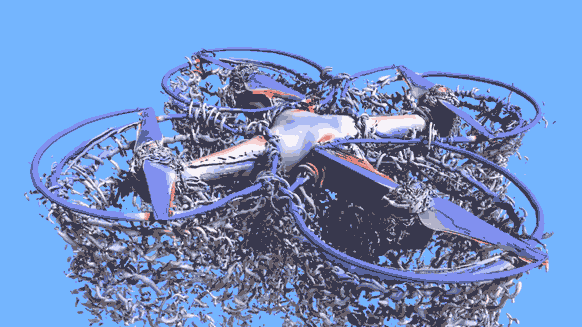If you’re the type of person who throws rocks at drones, or if you’ve ever shot one out of the sky with a shotgun because it invaded your airspace, I have some bad news for you---other than your pending civil lawsuit. Drones will be everywhere soon. Just imagine all that infuriating bvrrr and wrrr and weeeeer.
But theoretically, drones don't have to be so loud. As designers improve their understanding of drone aerodynamics, they have the potential to quiet the machines down and make them more efficient by reducing turbulence. And to that end, NASA scientists have generated an incredible visualization of the air currents and pressures of a quadcopter in flight.
Check out the GIF below. The blue bits are areas of low pressure, red is high, and the white stringy stuff is disturbed air. Aerospace engineer Seokkwan Yoon and scientific visualization specialist Tim Sandstrom---both from NASA---visualized those dynamics not by imaging a drone midflight, but by using a digital model. They began with a 3-D scan of a drone, running a simulation on 1,024 cores of NASA's Pleiades supercomputer (your computer is probably a dual-core or quad-core) to model the motion of air around the craft. Even with all that power, it took the supercomputer five days to complete.
So, what are we seeing here? For one, notice that the tops of the blades are a low-pressure blue. But what you can’t see are the undersides of the blades, which would be high-pressure red. It’s this pressure differential that produces the thrust that propels the drone.
But here's the problem with quadcopters. As a rotor slices over the four-armed body of the drone, it sends ripples of pressure across the surface---those trippy-looking flashes of blue and red. “When the rotors pass over the arms, the fuselage creates a large download (downward force), which in turn reduces the total thrust,” Yoon says in an email. In addition, the interactions between the rotors and fuselage can lead to wobble, making the drone unstable if it doesn’t have automatic flight control (a system that takes a chunk out of battery life, what with the computation power and all that course correcting).
The visualization also exposes how drones create all that cacophony. See those blue circles of low pressure created by the blades' tips? Well, the rotors end up slicing back through those circles, creating the disturbance that makes a drone so noisy. With the help of visualizations like these, designers might find ways to redesign their drones to hush up a bit.
Those pressure maps could also help designers optimize stability---a crucial requirement for retailers like Amazon, if they start using drones to deliver packages. Small drones, after all, don’t get along well with gusts of wind. And they especially don’t get along well with the sides of buildings the wind blows them into. “If we really want to realize services such as Amazon and other companies are dreaming about, we may need to look into other design configurations to address these safety issues,” Yoon says.
So put down that shotgun. The future is quieter---I promise.

